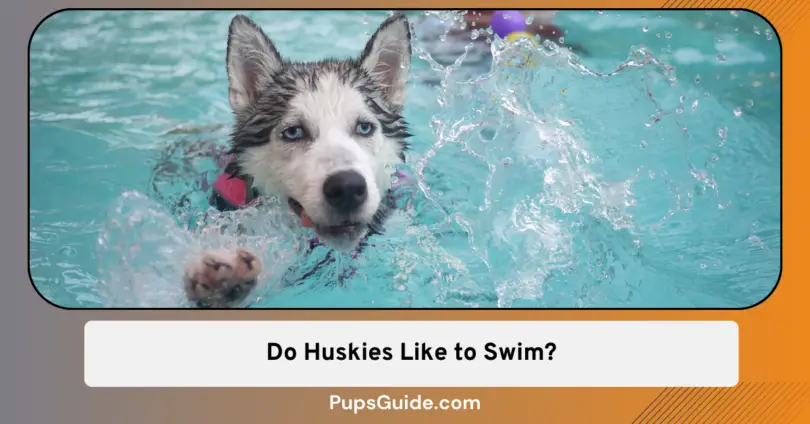Curiosity often surrounds the question of whether Siberian Huskies, with their arctic roots, have an innate inclination towards swimming.
In a nutshell, Siberian Huskies are not typically drawn to water due to their cold weather heritage, characterized by a thick double coat and webbed paws designed for snowy terrains.
However, this doesn’t mean your husky can’t become a water enthusiast with the right approach.
Read on to teach your husky how to swim.
Do Huskies Like To Swim? Teaching Your Husky to Swim
Contrary to popular belief, many huskies can learn to enjoy swimming through positive reinforcement and gradual exposure.
But for that to happen, you’ll have to take a husky’s individual personality into account, as some may naturally gravitate towards water, while others may require a bit more encouragement.
Factors to Consider
These are the factors you should definitely consider before subjecting your dog to a month-long or even longer training.
1. Understanding Individual Personality:
The first one is, obviously, personality. I sometimes think that huskies are creatures with cat software. You’ll have to be pretty careful with them.
a. Observation:
Start by observing your husky’s behavior around water. Notice if they show any curiosity or reluctance. This initial assessment will help you tailor your approach based on their unique personality.
b. Gradual Introduction:
For huskies that are initially hesitant, introduce them to shallow water first. Let them explore at their own pace, gauging their comfort level before progressing to deeper areas.
c. Patience and Encouragement:
Be patient and offer words of encouragement. If your husky is anxious, avoid forcing them into the water. Instead, use positive reinforcement, like treats or toys, to associate water with positive experiences.
2. Early Exposure:
Once you know that your dog is fond of water, the next step is its first exposure.
a. Puppy Playtime:
Start exposing your husky to water when they are still a puppy. This is a crucial developmental stage where positive associations are easily formed. Use a kiddie pool or a shallow basin for controlled exposure.
b. Positive Reinforcement:
You’ll have to incorporate this at every step because a dog learns well when it’s rewarded. Here, you should refrain from using negative reinforcement techniques because that can lead to negative associations.
So, reward your puppy with treats and praise during and after their water exposure. This helps create a positive connection with water from an early age.
c. Gradual Progression:
Gradually increase the depth of water as your dog becomes more comfortable. Always observe their reactions and adjust the pace accordingly.
3. Creating Positive Experiences:
Positive reinforcement can come in different forms. With treats, the following activities also play a crucial role in establishing the right connections between the pup and swimming.
a. Playful Interaction:
Turn water-related activities into playtime. Toss toys into shallow water and encourage your husky to retrieve them. This not only engages them mentally but also makes water activities enjoyable.
b. Treat Rewards:
When your husky responds positively to water, reward them with treats. Doing it will reinforce the idea that water equals positive experiences as I said above.
c. Bonding Time:
Use swimming sessions as bonding opportunities. The pup should know that you are in this, too. This way, it will start trusting the water body more and more.
To do that, engage in gentle petting and praising while in the water to strengthen the connection between you and your husky.
4. Training with Basic Commands:
Using voice commands completely elevates your game of teaching the dog swimming.
As dogs learn by associating different things with each other, they will learn that a certain command means something when they are in the water.
But to teach the dog all those commands, you’ll have to start dry.
Here’s how to do that.
a. Command Introduction:
During dry training sessions, introduce basic swimming commands like “paddle” or “fetch.” Associate these commands with positive experiences by offering treats or playtime as rewards.
b. Consistent Practice:
Practice these commands regularly, even outside of swimming sessions. The consistency you build up helps reinforce the association between the commands and the enjoyable activity of swimming.
c. Gradual Integration:
As your husky becomes proficient in responding to commands, gradually integrate them into actual swimming sessions. In the long run, it will enhance their swimming skills and better yet, make the training process fun.
Things to Consider or Remember:
Teaching the dog to swim isn’t without risks. That’s where you have to be vigilant and learn what things you should consider for the dog’s safety.
Never Leave Unattended:
Huskies, despite their strength, can struggle in deep water due to their dense fur. Never leave them unattended near water, even if they appear comfortable, to prevent any unforeseen incidents.
I would recommend you don’t leave them even for a minute. Do you have to take a quick call? First, take the husky out of the water. Do you want to go to the loo? Only after your dog’s out of the pool and inside to safety.
It’s so easy to forget what we left in the pool when our minds divert to other things.
Supervise and Choose Safe Areas:
Always supervise swimming sessions and opt for safe areas with gradual entry points to provide a secure environment for the dog to explore their newfound love for swimming.
Provide Drying Towel and Warmth:
After swimming sessions, make sure to provide a drying towel and a warm environment, especially during colder weather.
Huskies can be susceptible to cold temperatures, and proper care post-swim is critical for their well-being.
Gradual Introduction is Key:
I already talked about this above. Rushing the process may lead to fear or reluctance.
Gradually introduce your husky to water, allowing them to build confidence at their own pace.
Health Check:
Before embarking on a swimming adventure, ensure your husky is in good health.
Consult with a veterinarian to rule out any potential issues that might hinder their ability to swim comfortably.
Keep Supplies Handy:
Keep supplies near you even if you’re using your own pool. You should have clean drinking water for the dog and yourself right by the poolside along with food.
The toys should be there as you may need them ahead during the activity.
Initial Training:
Before learning to swim, your dog should be familiar with basic commands. You’re supposed to make sure that you’re the boss around.
Huskies are assertive dogs and they could easily outmaneuver you in the pool, thus, making the whole activity harmful to everyone.
You can also read: Top 7 Shock Collar for Husky
Conclusion
Seeing your husky enjoy swimming is a wholesome experience, but do not try to step into this unknown territory with a husky that doesn’t have a personality for swimming.
This is where responsibility kicks in.
By understanding your husky’s unique traits, employing positive reinforcement, and adhering to safety measures, you can unveil the aquatic potential within these cold-weather canines, turning them into enthusiastic swimmers.








Leave a Comment